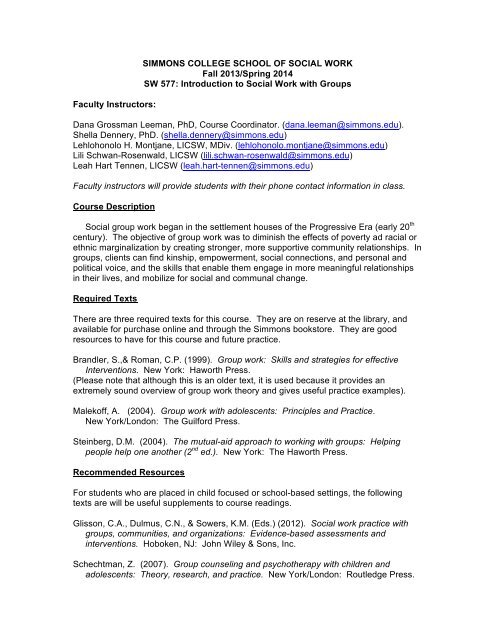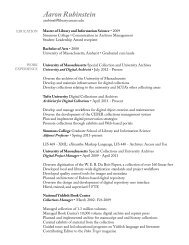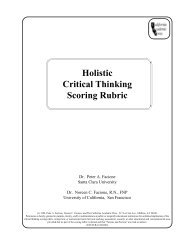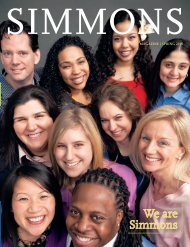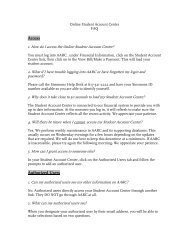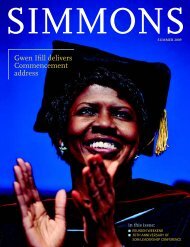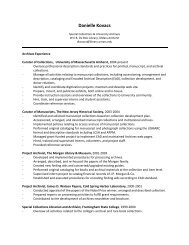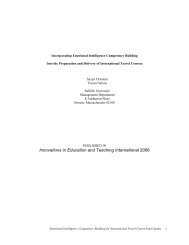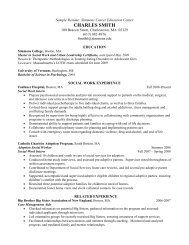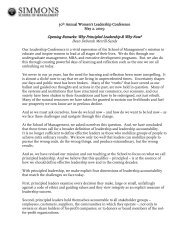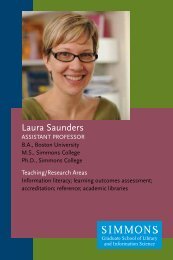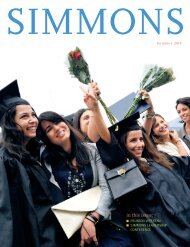Introduction to Social Work with Groups Faculty ... - Simmons College
Introduction to Social Work with Groups Faculty ... - Simmons College
Introduction to Social Work with Groups Faculty ... - Simmons College
Create successful ePaper yourself
Turn your PDF publications into a flip-book with our unique Google optimized e-Paper software.
www.evidencebasedgroupwork.com (Mark Macgowan’s site dedicated <strong>to</strong> all thingsevidenced based group work).www.iaswg.org (the official website of the International Association of <strong>Social</strong> <strong>Work</strong> <strong>with</strong><strong>Groups</strong>. The Standards for <strong>Social</strong> <strong>Work</strong> <strong>with</strong> <strong>Groups</strong> can be located on this website, aswell as other helpful group work resources.www.aaswgma.org (the official website of the MA Chapter of the InternationalAssociation of <strong>Social</strong> <strong>Work</strong> <strong>with</strong> <strong>Groups</strong>.Council on <strong>Social</strong> <strong>Work</strong> Education (CSWE) Core Competencies and PracticeBehaviorsThe 2008 Educational Policy and Accreditation Standards (EPAS) developed by theCouncil on <strong>Social</strong> <strong>Work</strong> Education (CSWE) both require and provide a framework forcompetency-based assessment of educational outcomes in social work trainingprograms. A description of the 10 core competencies and associated foundation andadvanced practice behaviors can be found on the SSW website through the followinglink <strong>with</strong>in the searchable Field Manual: http://simmons.edu/ssw/for/msw/fieldeducation/manual/files/12%20-%20Student%20Learning%20in%20Field.pdf.Student outcomes and learning objectives for this course are based on five out of the tencore competencies.Competency2.1.2. Apply social work ethical principles <strong>to</strong> guide professional practice.Practice BehaviorsMake ethical decisions by applying the NASW Code of Ethics and the IASWG Standardsfor <strong>Social</strong> Group <strong>Work</strong> Practice.Competency2.1.3. Apply critical thinking <strong>to</strong> inform and communicate professional judgments.Practice BehaviorsDemonstrate effective oral and written communication in working <strong>with</strong> individuals,families, groups, organizations, communities, and colleagues.Distinguish, appraise and integrate multiple sources of knowledge, including researchbasedknowledge and practice wisdom.Competency2.1.4. Engage diversity and difference in practice.Practice BehaviorsStudents view themselves as learners and engage those <strong>with</strong> whom they work asinformants.Gain sufficient self-awareness <strong>to</strong> eliminate the influence of personal biases and valueswhen working <strong>with</strong> diverse groups.Competency2.1.6. Engage in research-informed practice and practice-informed research.
Practice BehaviorsUse practice <strong>to</strong> inform scientific inquiry.Use research evidence <strong>to</strong> inform practice.Competency2.1.10. Engage, assess, intervene, and evaluate groups, communities, andorganizations.Practice BehaviorsUse empathy and other interpersonal skills in practice <strong>with</strong> groups.Develop a mutually agreed upon focus of work and desired outcomes <strong>with</strong> groupmembers.Assess client strengths and limitations.Facilitate transitions and endings.Learning Objective Practice Behaviors Assignments Use of Reciprocal Model/Mutual Aid Perspective. Increase knowledge and use of developmental theory, and worker’s skills during phases of group development. Knowledge of Group Typology Differential use of self in group work practice. Use empathy and other interpersonal skills in practice <strong>with</strong> groups. Develop a mutually agreed upon focus of work and desired outcomes <strong>with</strong> group members. Assess client strengths and limitations. Facilitate transitions and endings. (Same practice behaviors as above). Demonstrate effective oral and written communication when working <strong>with</strong> individuals, families, groups, organizations, and communities. Same practice behaviors as above. Incorporates all of the five competencies and related practice behaviors that this course claims. Classroom discussions, role plays, in-‐class experiential group, final written assignment. Classroom discussions, role plays, observation of community-‐based support group, in-‐class experiential group, final written assignment. Natural group observation and reaction paper. Observation of community-‐based group and reaction paper. Class discussion In-‐class experiential group, natural group observation and reaction paper, community-‐based
Knowledge and application of role theory. Knowledge of the impact of agency culture on group development and group member’s experiences. Explore the impact of worker-‐group member diversity on group process. Application of evidence-‐based group work practice Identify and understand the meaning and impact that group member’s roles have on group development, sense of safety and cohesion, and act as catalysts for intrapersonal and interpersonal change. Ability <strong>to</strong> identify the impact of agency culture and the ways in which it is impacting worker or group member experience. Engage diversity through thoughtful discussion and acknowledge the impact of worker-client or between group member diversity on safety, cohesion and group development. Identification of an area of inquiry. Formulate an answerable question. Search for evidence. Assess evidence for rigor, merit and utility. Apply evidence <strong>to</strong> consider changes in practice. Assess group observation and reaction paper, evidence-‐based classroom small group assignment and paper, final written assignment. Community-‐based group observation and reflection paper, in-class experiential group, final written assignment. Classroom discussions. Class room-‐based role play. Community-‐based group observation and reflection paper. In-‐class experiential group. In class evidence based small group assignment and written paper. Final written assignment. Classroom discussions. EBP written assignment. In-‐class experiential group. Final written assignment. In-‐class EBP small group assignment. EBP written paper.
effectiveness of practice. Evaluation of Student PerformanceClass participation. You are responsible for completing readings before class and beingprepared <strong>to</strong> apply them in class discussions. Class discussion includes in-classdiscussions and exercises, and where applicable, on-line assignments. In classdiscussion and on-line participation should reflect the social worker’s professionalresponsibility for respectful interactions and attentiveness <strong>with</strong> fellow students andfaculty. Please review the student policy manual for SSW standards for professionaldevelopment and the honor code.Written Assignments. Your individual instruc<strong>to</strong>r will explain his/her expectations forwritten assignments and specific grading criteria. Each paper is due on the date notedin the syllabus. Any exception must be explained in advance <strong>with</strong> your instruc<strong>to</strong>r. Pleasecheck <strong>with</strong> your instruc<strong>to</strong>r about on-line submission of papers.Attendance, Attentiveness and Punctuality.• You are allowed one absence per semester. More than one absence willinfluence the evaluation of a student’s performance and grade. Students areexpected <strong>to</strong> let faculty know when they are unable <strong>to</strong> attend class. Students areresponsible for making up missed content or work during an absence.• Repeated lateness will also impact a student’s performance and grade.• Students are required <strong>to</strong> apprise faculty of tardiness. When late, please enterin<strong>to</strong> class quietly and <strong>with</strong> minimal disruption.• Texting, the use of social networking of any kind, or computers, phones andpersonal electronic devices for non class-related activities is prohibited.Each student’s final grade will be based on the following criteria:• Class participation: 20%• Natural Group Observation and reflection paper: 10%• Attendance at a community-based group of choice and reflection paper: 10%• In-class evidence-based group work practice small group assignment and paper:25%• Critical Incident Analysis/Final Assignment: 35%Statement on DisabilitiesReasonable accommodations will be provided for students <strong>with</strong> documented physical,sensory, systemic, cognitive, learning and psychiatric disabilities. If you have adocumented disability that requires assistance, you will need <strong>to</strong> contact the DisabilityServices Office at the beginning of the semester <strong>to</strong> request accommodations. Contactthe DSO at 617.521.2470. Students requesting accommodation must do so eachsemester. Students receiving accommodations are also encouraged <strong>to</strong> inform theiradvisor and contact their instruc<strong>to</strong>rs <strong>with</strong>in the first two weeks of the semester <strong>to</strong>discuss their individual needs for accommodation.
example, you may use “a large teaching hospital in an urban area,” rather than referringby name <strong>to</strong> MGH or Brigham and Women’s Hospital, for example. You can refer <strong>to</strong> atherapeutic school in a suburb or Bos<strong>to</strong>n, or a community health center <strong>with</strong>out using theactual name. You can refer <strong>to</strong> treatment or services that <strong>to</strong>ok place in Oc<strong>to</strong>ber, 2010 bysaying that “client presented for help about eight years ago when client was around 10,”and omitting the year in which the work <strong>to</strong>ok place. Not adequately obscuring identifyinginformation is a violation of HIPAA and may directly impact your grade on anassignment.Please note that the syllabus is not a contract. The instruc<strong>to</strong>r reserves the right <strong>to</strong>alter the course requirements and/or assignments based on new materials, classdiscussions or other legitimate pedagogical objectives.AssignmentsThe assignments and their requirements are listed in the order that they are due.Assignment #1, Natural Group observation and reflection paper, due in the first class(Session #1). This paper should not exceed 2 pages.For 20 minutes, observe a natural group of choice. A natural group is defined as threeor more people who happen <strong>to</strong> be in the same place at the same time. You can observenatural groups anywhere. A family is not a group.For the reaction paper, consider and reflect upon the following:• What do you see when you observe this group? How and where do people sit?What do you notice about their non-verbal communication? Body language, etc.• How do the group members interact?• How do people relate <strong>to</strong> each other?• What about this group makes you curious?• What did you learn about this group?Assignment #2 Community-based group observation and reflection paper, due insession #3. This paper should not exceed 2 pages.Attend any community-based group of your choice. You must identify yourself as asocial work student. Not doing so violates the NASW Code of Ethics as you may beseen <strong>to</strong> be representing yourself as a consumer and not a student. You may locategroups on-line and in the newspaper. Please be sure not <strong>to</strong> attempt <strong>to</strong> attempt a closedgroup, as you will be asked <strong>to</strong> leave. Please address consider the following in yourwritten discussion:• What did you observe about this group?• Describe the culture of the group? Did you note any rituals or traditions?• What was it like <strong>to</strong> locate and attend this group? What kinds of thoughts,feelings, and associations did you have when walking in<strong>to</strong> the room andthroughout the meeting?• According <strong>to</strong> the literature, what type of group did you attend? Please cite thespecfic data source <strong>to</strong> support your ideas.Assignment #3. Evidence-Based Group <strong>Work</strong> Assignment
Part I in Session #6: In class, you will be divided in<strong>to</strong> small work groups. As a groupyou will discuss your group work <strong>with</strong> each other. Decide as a group a domain of grouplife that you all have in common (facilitation, agency culture, group composition, type ofgroup, etc) and formulate an answerable question that assesses the impact of thisdomain on the group. For example, you may collectively decide <strong>to</strong> assess the impact ofmale-female co-facilitation of safety or cohesion in a group of adolescent males. Onceyou have formulated this question, <strong>to</strong>gether, search for evidence. Find two datasources, review them <strong>to</strong>gether and then assess their rigor and merit according <strong>to</strong>Macgowan’s Hierarchy of Rigor and Merit.Part II due in Session #7: Based on your small group work, take the evidence andapply it <strong>to</strong> your particular group. How does the evidence change your thinking aboutyour practice? How might you apply the evidence <strong>to</strong> your group <strong>to</strong> make it moreeffective? If your agency asked you <strong>to</strong> design a study <strong>to</strong> prove the effectiveness of yourgroup in order <strong>to</strong> continue offering it as a service <strong>to</strong> clients, how would you go aboutassessing this and how would you involve group members in this process, which isconsistent <strong>with</strong> the values of evidence-based group work practice.Please do not exceed four pages (12 pt font, double spaced, 1” margins) and citeappropriate data sources.Assignment #5, Critical Incident Analysis, Due in Session #13.This assignment offers you the opportunity <strong>to</strong> reflect on and integrate the readings, classdiscussions, your experience <strong>with</strong> groups this semester, either at your placement or thein-class experiential group. As yourself: Are there specific critical incidents that standout in my experiences facilitating or co-facilitating, participating in or observing groups?This paper should be 8-10 pages, double spaced, 1” margins, and formatted according<strong>to</strong> the APA Manual, 6 th edition.Critical incidents are those practice situations, classroom events, and lifeexperiences that crystallize an understanding, raise hard questions, presentdilemmas or remain lingering and unresolved.1. Select a “critical incident.” This can be an incident from one group, or a patternthat emerged in a few group sessions.2. Write up in the incident in some detail so that you can use it as a frame ofreference. Please include:• Community and setting where the group takes place.• Group purpose.• Brief description of the group composition: members gender, age, race,ethnicity, culture, presenting complaints and/or reason for referral <strong>to</strong> the group.• Structure of the group-as-whole (norms, roles, how members interact andcommunicate <strong>with</strong> each other, sessional beginnings and endings, etc.)3. Focus on the interventions. Use process if you have and if not, try <strong>to</strong> describethe dialogue in as much detail as possible so that you can capture the contextand conversation.
Association for the advancement of social work <strong>with</strong> groups, inc., (2006). Standardsfor social work practice <strong>with</strong> groups. You may retrieve this at the www.iaswg.orgwebsite. Please print them out, review them and keep them <strong>with</strong> you for the semester.Kurland,R., & Salmon, R. (1998). Purpose: A misunders<strong>to</strong>od and misused keys<strong>to</strong>ne ofgroup work practice. <strong>Social</strong> <strong>Work</strong> <strong>with</strong> <strong>Groups</strong>, 21(3), 5-17.Kurland, R., & Salmon, R. (1993). Groupwork versus casework in a group.Groupwork, 6(1), 5-16.Suggested reading:Clemans, S.E. (2011). The purpose, benefits, and challenges of “check-in” in a groupworkclass. <strong>Social</strong> <strong>Work</strong> <strong>with</strong> <strong>Groups</strong>, 34(2), 121-140.Session #IIObjectives:To define group work versus individual casework in a group setting.Discuss latent versus manifest content.<strong>Work</strong>er’s functions (Gitterman & Shulman)<strong>Introduction</strong> <strong>to</strong> group development: three comparative models of groupdevelopment (Bos<strong>to</strong>n Model, Mutual Aid, Feminist Relational Model).Assigned Readings:Brandler, S., & Roman, C.P. (1999). Group work: skills and strategies for effectiveinterventions (pp. 9-13; 15-40). New York: Haworth Press.Kurtz, L.F. (2004). Support and self-help groups. In C.D. Garvin, L.M. Gutierrez, andM.J. Galinsky (Eds.), Handbook of social work <strong>with</strong> groups (pp. 139-159). NewYork: The Guilford Press.Malekoff, A. (2004). Group work <strong>with</strong> adolescents: principles and practice (pp.35-52).New York/London: The Guilford Press.Session #III:Objectives: We will begin <strong>to</strong> watch and discuss, in depth, a mandated adolescentgroup, which you will see evolve from the pre-affiliation phase through termination.Assignment #2 is due <strong>to</strong>day.Assigned Readings:Cox, E.O. (1991). The critical role of social action in empowerment oriented groups. InA. Vinik and M. Levin (Eds.), <strong>Social</strong> action in group work (pp. 77-90). New York:The Haworth Press.
Malekoff, A. (2004). Group work <strong>with</strong> adolescents: principles and practice (pp. 53-58).New York/London: The Guilford Press.Steinberg, D.M. (2004). The mutual-aid approach <strong>to</strong> working <strong>with</strong> groups: helpingpeople help one another (pp. 3-8; 13-33). New York: The Haworth Press.Wayne, J., & Gitterman, A. (2003). Offensive behaviors in groups: challenges andOpportunities. <strong>Social</strong> <strong>Work</strong> <strong>with</strong> <strong>Groups</strong>, 26 (2), 23-34.Doi: 10.13000/J009v26N02_03Suggested Readings:These are not required readings, but for those interested in reading more about groupconflict, challenging group members, and variations on power and control, you may alsoconsult the following data sources:Gitterman, A. (2003). Dealing <strong>with</strong> group members’ testing of authority. <strong>Social</strong> <strong>Work</strong><strong>with</strong> <strong>Groups</strong> 25 (1/2), 185-192.Gitterman, A, & Wayne, J. (2003). Turning points in group life: Using high tensionmoments <strong>to</strong> promote group purpose and mutual aid. Families in Society, 84 (3).For those interested in or are currently working <strong>with</strong> children:Schechtman, Z. (2007). Group counseling and psychotherapy <strong>with</strong> children andadolescents (pp. 30-35; 123-137). New York/London: Routledge Press.Session IV and V:Objectives: To define and exemplify the following group work skills:sessional contractinglimit settingelaboration skillsmediation skillsscanningskills of support and sustainmentpre-group planningconsistency and structure.group rules and policies (attendance, lateness, acting out, and leaving thegroup).Content versus process response.Group-as-a-whole interventions.Impact of agency setting and time.Use and impact of silence.Impact of worker’s gender, race, age, ethnicity and sexual orientation onthe group-as-a-whole, and vice versa.Ethics and Group <strong>Work</strong> Practice (Session V)Assigned Readings: (please note that this is a heavier reading load, but these areassigned readings for two weeks.)
Brandler, S., & Roman, C.P. (1999). Group work: skills and strategies for effectiveinterventions, second edition (pp. 41-80; 207-229). New York: The Haworth Press.Northen, H. (2004). Ethics and values in group work. In C.D. Garvin, L.M. Gutierrez,& M.J. Galinsky (Eds.). Handbook of <strong>Social</strong> <strong>Work</strong> <strong>with</strong> <strong>Groups</strong> (pp. 76-90). NewYork: The Guilford Press.Olivier, C. (2009). Enhancing the confidentiality <strong>with</strong>in small groups: The experiencesOf AIDS service organizations. <strong>Social</strong> <strong>Work</strong> <strong>with</strong> <strong>Groups</strong>, 32(4), 274-287.Steinberg, D.M. (2004). The mutual-aid approach <strong>to</strong> working <strong>with</strong> groups: helpingpeople help one another (pp. 35-75). New York: The Haworth Press.Suggested Readings:Hall, K.R. (2006). Solving problems <strong>to</strong>gether: A psychoeducational group model forVictims of bullies. The Journal for Specialists in Group <strong>Work</strong>, 31(3), 201-217.Levy, R. (2011). Core themes in a support group for spouses of breast cancer patients.<strong>Social</strong> <strong>Work</strong> <strong>with</strong> <strong>Groups</strong>, 34(2), 141-157.Lopez, C., & Bhat, C.S. (2007). Supporting students <strong>with</strong> incarcerated parents inschools: A group intervention. The Journal for Specialists in Group <strong>Work</strong>, 32(2),139-153.Session VIObjectives: Evidenced Based Group <strong>Work</strong> Practice. Exploration of values andpractice. In-class exercise.Objectives: Assigned Readings:Macgowan, M.J. (2008). A guide <strong>to</strong> evidence-based group work. New York: OxfordUniversity Press (pp. 1-17; 21-30; 78-118).Choose one of the following (Please come prepared <strong>to</strong> discuss your article <strong>with</strong> theclass.)Ellis, J.A. & Camardese, M. (2011). Group work <strong>with</strong> operation enduring freedomand operation Iraqi freedom combat veterans. In Greif, G.L., & Ephross, P.H.(Eds.). Group work <strong>with</strong> populations at risk (pp. 153-169). Oxford/New York:Oxford University Press.Gonzalez, A., Lord, G., Rex-Kiss, B., & Jean Francois, J. (2012). Parents beyondborders: a social work curriculum for supporting immigrant parents and buildingsolidarity. <strong>Social</strong> <strong>Work</strong> <strong>with</strong> <strong>Groups</strong>, 35(1), 18-34.Macgowan, M.J. (2011). Finding and integrating the best available evidenceIn<strong>to</strong> the group work field practicum: examples and experiences from students.In Macgowan, M.J. & Pollio, D.E. (Eds.). Evidence-based group work in
Community settings (pp. 110-128). New York and London: Routledge Press.Mishna, F., Muskat, B., & Weiner, J. (2011). “I’m not lazy; it’s just that I learndifferently”: development and implementation of a manualized school-basedgroup for students <strong>with</strong> learning disabilities. In Macgowan, M.J., & Pollio, D.E.(Eds.). Evidence-based group work in community settings (pp. 37-57). New Yorkand London: Routledge Press.Session VII:Objectives: EBP written assignment is due in class <strong>to</strong>day.Conceputalizing group work <strong>with</strong> at-risk populations- principles andpractices.Assigned Readings:Horvath, T., & Yeterian, J. (2012). SMART recovery: Self-empowering, sciencebasedaddiction & recovery. Journal of <strong>Groups</strong> in Addiction & Recovery, 7(2-4),1-2-117.Olson-McBride, L., & Page, T.F. (2012). Song <strong>to</strong> self: A therapeutic dialogue <strong>with</strong> highriskyouths through poetry and popular music. <strong>Social</strong> <strong>Work</strong> <strong>with</strong> <strong>Groups</strong>, 35(2), 124-137.Thomas, H., & Caplan, T. (1999). Spinning the group process wheel: Effectivefacilitation techniques for motivating involuntary client groups. <strong>Social</strong> work <strong>with</strong>groups, 21 (4), 3-21.Please choose from one of the following:Goodrich, K.M., & Luke, M. (2010). The experiences of school counselors-in-trainingin group work <strong>with</strong> LGBTQ adolescents. The Journal for Specialists in Group<strong>Work</strong>, 35(2), 143-159.Kenny, M.C. (2009). Child sexual abuse prevention: Psychoeducational groups forpreschoolers and their parents. The Journal for Specialists in Group <strong>Work</strong>, 34(1),24-42.Spiegelman, J.S., & Werth, J.L., Jr. (2005). Don’t forget about me: the experiencesOf therapists–in-training after a client has attempted suicide. Women & therapy, 28(1), 35-57.Steen, S. (2009). Group counseling for African American elementary students: AnExplora<strong>to</strong>ry study. The Journal for Specialists in Group <strong>Work</strong>, 34(2), 101-117.Strom-Gottfried, K., & Mowbray, N.D. (2006). Who heals the helper? Facilitatingthe social worker’s grief. Families in society, Jan-Mar; 87(1), 9-15.Session VIII:Objectives: To explore how diversity impacts group members and group process, andthe importance of directly addressing difference in group.
Community Organization: Exploring principles, values, and practice.Assigned Readings:Camacho, S.F. (2001). Addressing conflict rooted in diversity: The role of the facilita<strong>to</strong>r.<strong>Social</strong> <strong>Work</strong> <strong>with</strong> <strong>Groups</strong>, 24(3/4), 135-152.Malekoff, A. (2004). Group work <strong>with</strong> adolescents: Principles and practice (pp. 207-232). New York: The Guilford Press.Miller, J., & Donner, S. (2000). More than just talk: The use of racial dialogues <strong>to</strong>combat racism. <strong>Social</strong> <strong>Work</strong> <strong>with</strong> <strong>Groups</strong>, 23(1), 31-53.Suggested Readings:Berg, K.K., & Simon, S.R. (2013). Developing a white anti-racism identity: APsychoeducational model. In Tully, G.J, Dolan-Reilly, G., Bacon, J., & Lo Re, A.,(Eds.). Group <strong>Work</strong>: An international conversation highlighting diversity in practice(pp. 90-115).Shin, R.Q., Rogers, J., Stanciu, A., Silas, M., Brown-Smythe, C., & Austin, B. (2010).Advancing social justice in urban schools through the implementation oftransformative groups for youth of color. The Journal for Specialists in Group <strong>Work</strong>,35(3), 230-235.Required Preparation for Session IX:In advance of the pre-group planning session, please think and journal about thefollowing. This is not time intensive, or it need not be!1. What kind of a group would I like <strong>to</strong> participate in?2. What kinds of rules might help me feel safe?3. Would I like <strong>to</strong> facilitate this group?4. What about creating and participating in this group leaves me feeling curious,excited, fearful, apprehensive, or unsafe?Session IX:Objectives: Pre-group planning for the In-class experiential group.Please note that the entire class will be dedicated <strong>to</strong> this work.Assigned Readings:Gans, J.S., & Counselman, E.F. (2000). Silence in group psychotherapy: A powerfulCommunication. International Journal of Group Psychotherapy, 50(1), 71-84.Schopler, J.H. & Galinsky, M.J. (1984). Meeting practice needs: Conceptualizing theopen-ended group. <strong>Social</strong> <strong>Work</strong> <strong>with</strong> <strong>Groups</strong>, 7(2), 49-68.Steinberg, D.M. (2004). The mutual-aid approach <strong>to</strong> working <strong>with</strong> groups: Helpingpeople help one another, 2 nd ed (pp. 77-124). New York: The Haworth Press.Session X:
Objectives: First in-class experiential group and post-group debrief.Student facilitated sessional ending.Assigned Readings:Brandler, S, & Roman, C.P. (1999). Group work: Skills and strategies for effectiveinterventions (pp. 83-111; 277-294). New York: The Haworth Press.Malekoff, A. (2004). Group work <strong>with</strong> adolescents: Principles and practice (pp. 329-338). New York: The Guilford Press.Choose 1 or 2 from the following selections based on your interests or area of practice.These articles cover group work <strong>with</strong> elders, trauma informed group work, inpatientgroup work, mandated groups, and groups in partial hospital programs.Chovanec, M. (2009). Faciliating change in a group work <strong>with</strong> abusive men: Examiningstages of change. <strong>Social</strong> <strong>Work</strong> <strong>with</strong> <strong>Groups</strong>, 32(1-2), 125-142.Emond, S., & Rasmussen, B. (2012). The status of psychiatric inpatient group therapy:Past, present, and future. <strong>Social</strong> <strong>Work</strong> <strong>with</strong> <strong>Groups</strong>, 35(1), 68-91.Poole, J., Gardner, P., Flower., M.C., & Cooper, C. (2009). Narrative therapy, olderAdults, and group work?: Practice, research, and recommendations. <strong>Social</strong> <strong>Work</strong>With <strong>Groups</strong>, 32(4), 288-302.Roe-Sepowitz, D. Pate, K.N., Bedard, L.E., & Greenwald, M. (2009). A trauma-basedGroup intervention for incarcerated girls. <strong>Social</strong> <strong>Work</strong> <strong>with</strong> <strong>Groups</strong>, 32(4), 330-241.Sessions XI and XIIObjectives: Continue, complete and debrief the in-class experiential group.These sessions will have student facilitated sessional endings.Assigned Readings:As you begin thinking about your critical incident paper, consider what literature wouldsupport your thinking and writing. Do a literature search <strong>to</strong> find two data sources thatyou might use <strong>to</strong> support or expand your analysis.Brandler, S., & Roman, C.P. (1999). Group work: skills and strategies for effectiveInterventions. New York: The Haworth Press.Pick a chapter you have not yet read.Dickey, l.m., & Loewy, M.I. (2010). Group work <strong>with</strong> transgender clients. The Journalfor Specialists in Group <strong>Work</strong>, 35(3), 236-245.Steinberg, D.M. (2004). The mutual-aid approach <strong>to</strong> working <strong>with</strong> groups: HelpingPeople help one another, 2 nd ed. New York: The Haworth Press.Pick a chapter you have not yet read.
Session XIIIObjectives: Final Paper due in class <strong>to</strong>day.This purpose of this session will be determined by your instruc<strong>to</strong>r based on class needor interests.Session XIV:Objectives: To evaluate the course, and terminate.Assigned Readings:Denning, Patt (2008). Interacting groups in the treatment of a woman <strong>with</strong> complexsubstance misuse and psychiatric illness. Journal of <strong>Groups</strong> in Addiction & Recovery,3(3-4), 193-215.


